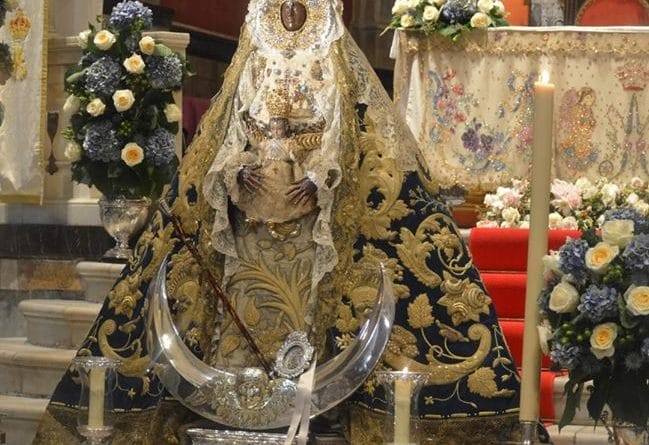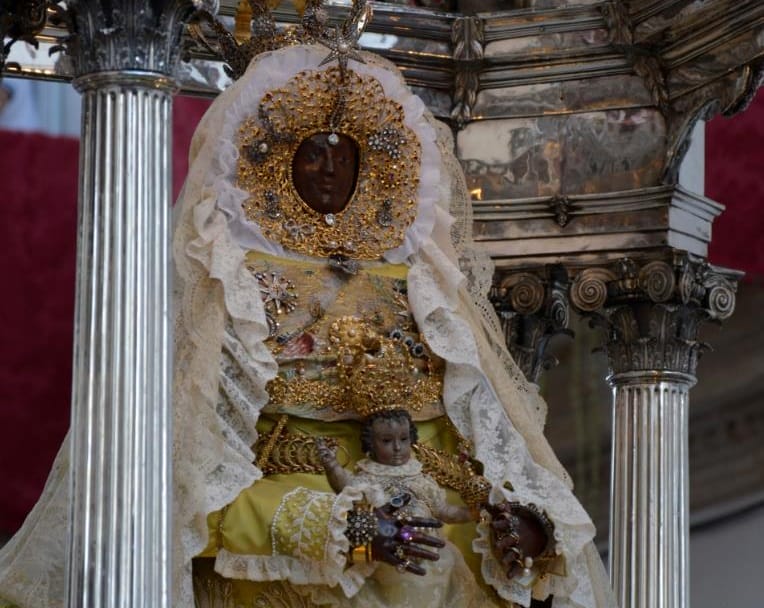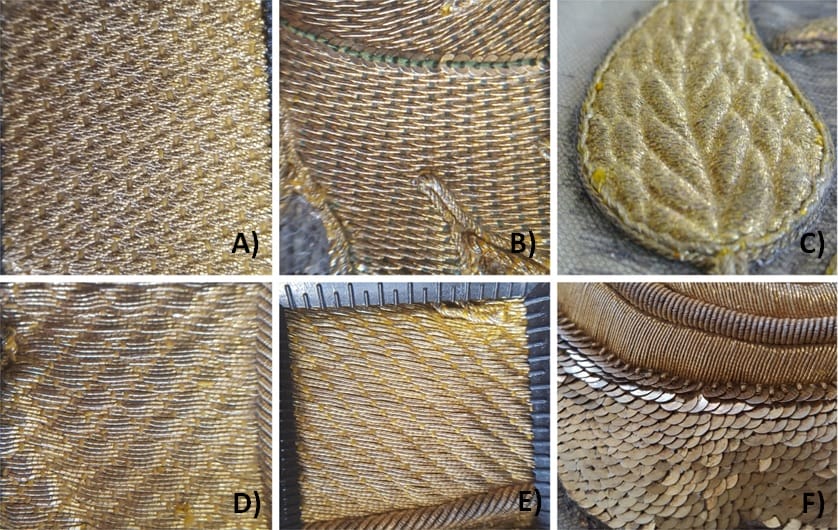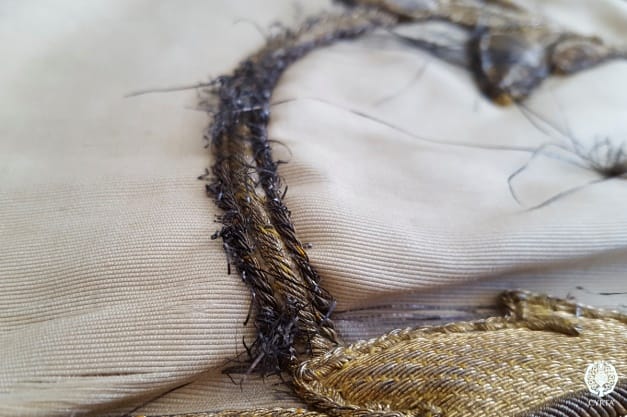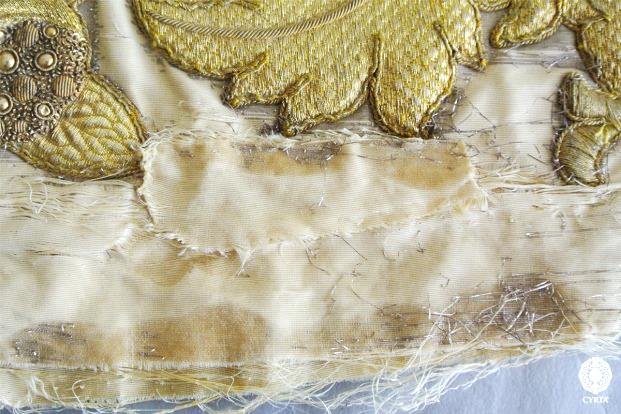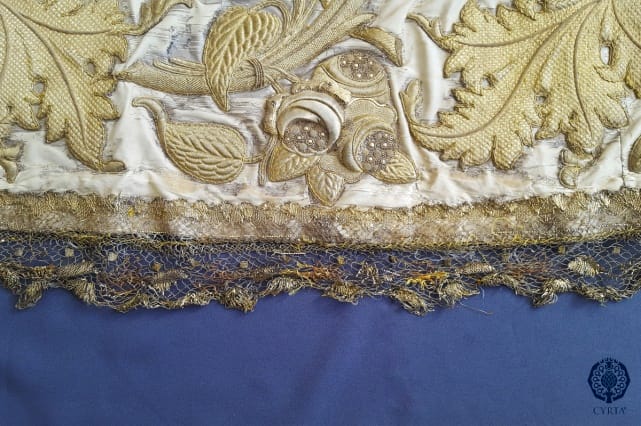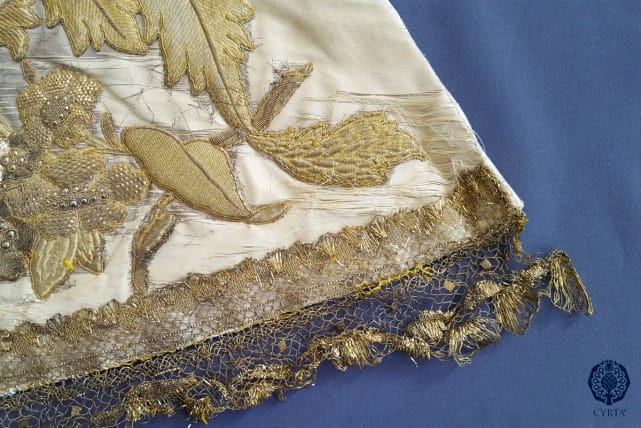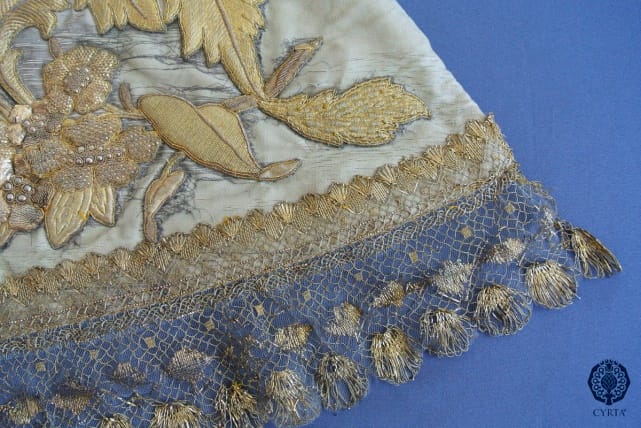The restoration of the embroidered dress of the Virgin of Miracles, patroness of the Port of Santa Maria. (Cadiz, Spain)
Translation by Marina Dlacic
Cyrta is a restoration company from Seville, active since 2016. The responsible restorers, Pablo Portillo and Pablo Perez, specialized in conservation and restoration of the textile heritage, have carried out training courses in Italy, with Ancient Viterbo textiles and the Penelope canvas from Prato. The restoration of the Virgin’s dress dates back to 2019.
The dressed Madonnas are complex historical artefacts both from the point of view of their realization and from a symbolic-functional point of view. A type of sculpture with a peculiar physiognomy made to be clothed, they are almost always made of a rather rough wooden armor, softened by padding to shape the body and allow a better fit.
Their fortune had different phases, linked to religious and devotional cults, their spread throughout the Catholic area dates back to the second half of the 16th century when aesthetic canons and liturgical modalities were established. The dressed simulacra have the task of channeling and standardizing the religious sentiments of the faithful.
From the end of the nineteenth century, ecclesiastical hierarchies began to show some opposition to these artifacts, guilty, in their opinion, of trivializing Catholic liturgical practices and evoking a pagan ritual too close to the archaic-peasant world.
The Virgin of Miracles, Port of Santa Maria. José Louis Sara
The Virgin of Miracles is an example of the spread of these artifacts in the Catholic world. It is known that in the seventeenth century the Virgin was fitted to be clothed and so it has passed down to the present day, an important contribution to her dressing were the donations made by Isabella of Valois (1468-1545) and by Isabella Clara Eugenia (1566-1633), fundamental for the creation of an iconographic model that favored the multiplication of the dressed Madonnas.
The documents kept in the Municipal Historical Archive of the Port of Santa Maria mention the donation of an embroidered dress consisting of a cloak with sleeves created by Terese del Cardillo, author of important pieces preserved in Andalusia.
Image of the dress before the restoration – Copyright Cyrta
The ornamental lines follow the prevailing patterns of the embroideries made in Seville in the second half of the 19th century which scholars have defined as a romantic style. This composition is mainly characterized by the use of voluminous floral and vegetable motifs of accentuated dynamism and marked naturalist character. In the case of the skirt, acanthus leaves and floral ensembles can be recognized in the lower extremities which flow into a central area where they intersect with a large palm leaf with a marked upward trend. The lateral ends, like the upper zone, are covered with thin stems that insinuate themselves into small flowers, leaves and ten-pointed stars.
The piece is completed, at the lower end, with Spanish stitch lace made with threads and metal foils. In the sleeves, the embroidery is placed on the lower ends and is formed by an acanthus leaf combined with delicate twigs and small flowers, the lower perimeter is finished with Spanish lace.
Thanks to the studies conducted, it can be asserted that originally the entire dress was supported by white velvet. However, it is known that in the first decades of the twentieth century, the embroideries were transposed onto the current support, known as silver lamè, consisting of a silk warp and a cast weft of very fine silver metallic sheets.
The ornamental embroidery of both the skirt and the sleeves are made with golden metallic thread using various embroidery techniques.
Testing done with an optical microscope on the twisted metal wire certify its high quality, both for the internal silk core and for the metal wire that surrounds it, made up of 15% silver and 85% gold. The embroidery stitches used vary within the dress and contribute to increasing its historical and artistic value, at the same time testifying to the execution expertise
Details of the metallic yarn embroidery – Copyright Cyrta
We have already mentioned that in the twentieth century the support for these embroideries was replaced with the so-called silver lamè and, although very deteriorated, this support still holds the embroidery. This replacement involved cutting the embroidery along the perimeter and fixing it to the new support through a seam and subsequently cutting between the individual elements of the decoration. The intervention has favored, in some cases, the distortion of some decorative details such as leaves and flowers, thus losing the finesse and immediate clarity of the decoration.
The general state of conservation of the piece was not good, both for the natural aging of the fibers and for the damage caused by use, due to the adaptations during the dressing of the Madonna.
The most alarming situations concerned the deformations caused by the support and the loss of the sheets of the metallic yarn, to which are added the lacerations affected by mending, especially on the upper end. In the lower area there are dowels joined to the support with seams and adhesive that have caused gaps and weakening of the support.
The embroidery had a high level of surface dirt and a high oxidation of the metallic yarn.
The intervention conducted by Cyrta was based on the founding criteria of the restoration theory; the work carried out prioritized the consolidation of the work through a conservative restoration that took into consideration respect for the original work and the restoration of its constituent elements, a rediscovered visual of the decorative motifs avoiding the introduction of false historians and recognizing the reversibility of the restoration.
The fabric was initially affected by a micro-aspiration at the capillary level, to eliminate dust residues and surface dirt, then the intervention focused on eliminating the mending that caused tensions and lacerations due to the thick yarn with which they were made .
Detail of the lace in metallic yarn before restoration – Copyright Cyrta
In the same way, the plugs were removed and repositioned in their original location. Once all the elements that constituted a source of tension and deformation were eliminated, the velvet support was moistened to rehydrate the fibers, promoting their elasticity to correct the deformations of the support.
For the cleaning of the metallic yarn, various tests have been carried out to identify the most suitable solvent, the cleaning of the metallic yarn presents numerous unknowns, having to take into consideration the composition of the coating bath and the delicacy of the yarn core.
Detail of the lace in metallic yarn before restoration – Copyright Cyrta
The consolidation focused on the most deteriorated velvet areas, they were reinforced on the back side with another support suitably sewn to the velvet with silk thread, on the straight side tulle was sewn which served a double function: on the one hand it ensures a greater protection of the fabric during subsequent uses, on the other hand it goes to fulfill a precise request from the client; the tulle was dyed with shades of gray to recreate the shimmering effect of the metallic yarn characteristic of the support used, this made it necessary to trim the tulle in the presence of gold to avoid the lowering of shades.
The lace present on the perimeter was very deformed and oxidized, it too was subjected to a thorough cleaning phase with a physical-chemical process and, subsequently, aligned trying to restore the original shape and size.
The restoration ended with the relocation of the lace and the stitching of a lining to cover the entire reverse.
Detail of the lace in metallic yarn after restoration – Copyright Cyrta
